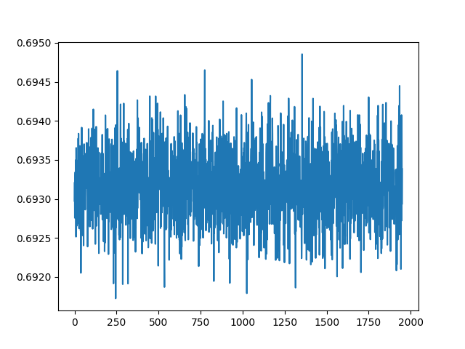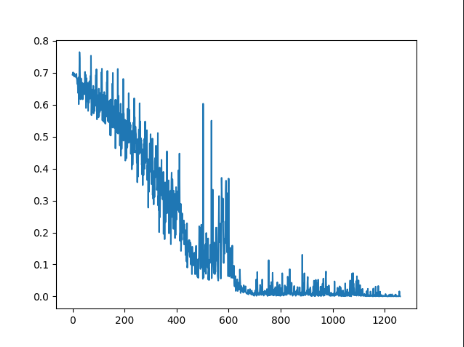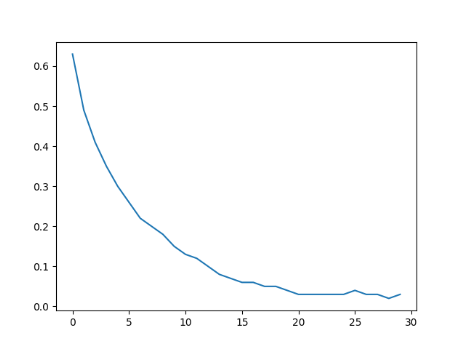I have a convolutional neural network in vgg architecture “style” (down below) to classify images if there is a cat on the picture, or a dog. My training set contains 25000 images cropped to 256px each side. I tried different learning rates, different loss functions and much more but my loss keeps fluctuating between 0.692 and 0.694, but it will not decrease…
normalize = transforms.Normalize(
mean=[0.485, 0.456, 0.406],
std=[0.229, 0.224, 0.225]
)
transform = transforms.Compose([
transforms.Resize(256),
transforms.CenterCrop(256),
transforms.ToTensor(),
normalize
])
# Output = [isDog, isCat]
train_data_list = []
train_data = []
target_list = []
plotlist = []
train_files = listdir("data/catsdogs/train/")
def loadTrainData():
global train_data_list
global train_data
global target_list
print("Loading data now...")
amount = len(listdir("data/catsdogs/train/"))
current = 0
for i in range(amount):
r = random.randint(0, len(train_files) - 1)
file = train_files[r]
train_files.remove(file)
img = Image.open("data/catsdogs/train/" + file)
img_tensor = transform(img) # (3, 256, 256)
isCat = 1 if 'cat' in file else 0
isDog = 1 if 'dog' in file else 0
target = [isCat, isDog]
train_data_list.append(img_tensor)
target_list.append(target)
if len(train_data_list) >= 64:
train_data.append((torch.stack(train_data_list), target_list))
train_data_list = []
target_list = []
current = current + 1
print("Loaded: {:.1f}%".format(current * 100 / amount))
print("Loaded data successfully!")
class Network(nn.Module):
def __init__(self):
super(Network, self).__init__()
self.conv1 = nn.Conv2d(3, 16, kernel_size=3, stride=1, padding=1)
self.conv2 = nn.Conv2d(16, 16, kernel_size=3, stride=1, padding=1)
self.conv3 = nn.Conv2d(16, 32, kernel_size=3, stride=1, padding=1)
self.conv4 = nn.Conv2d(32, 32, kernel_size=3, stride=1, padding=1)
self.conv5 = nn.Conv2d(32, 64, kernel_size=3, stride=1, padding=1)
self.conv6 = nn.Conv2d(64, 64, kernel_size=3, stride=1, padding=1)
self.dropout = nn.Dropout2d()
self.relu = nn.ReLU(inplace=True)
self.pool = nn.MaxPool2d(kernel_size=3, stride=3, padding=0, dilation=1, ceil_mode=False)
self.fc1 = nn.Linear(5184, 1296)
self.fc2 = nn.Linear(1296, 2)
def forward(self, x):
# Block 1
x = self.conv1(x)
x = self.relu(x)
x = self.conv2(x)
x = self.relu(x)
x = self.pool(x)
# Block 2
x = self.conv3(x)
x = self.relu(x)
x = self.conv4(x)
x = self.relu(x)
x = self.pool(x)
# Block 3
x = self.conv5(x)
x = self.relu(x)
x = self.conv6(x)
x = self.relu(x)
x = self.pool(x)
x = x.view(-1, 5184)
x = F.relu(self.fc1(x))
x = self.dropout(x)
x = self.fc2(x)
return torch.sigmoid(x)
model = Network()
model = model.cuda()
optimizer = optim.SGD(model.parameters(), lr=0.0001, weight_decay=0.0016)
def train(epoch):
global optimizer
model.train()
batch_id = 0
for data, target in train_data:
data = data.cuda()
target = torch.Tensor(target).cuda()
data = Variable(data)
target = Variable(target)
optimizer.zero_grad()
out = model(data)
criterion = F.binary_cross_entropy
loss = criterion(out, target)
loss.backward()
optimizer.step()
plotlist.append(loss)
print('Train Epoch: {}, {:.0f}% ,\tLoss: {:.6f}'.format(
epoch, 100. * batch_id / len(train_data), loss.item()
))
batch_id = batch_id + 1
loadTrainData()
for epoch in range(25):
train(epoch)
plt.plot(plotlist)
plt.show()
plt.ylabel("Loss")
plt.savefig("lossPlot.png")
If I increase the learning rate, the fluctuation get heavier… For example for lr = 0.1 between 0.5 and 0.7
Also here is a plot of my loss over 5 iterations with lr 0.0001:


